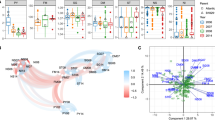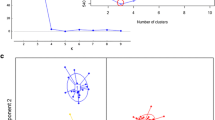Abstract
Medicago truncatula, as a model species, is useful to study the genetic control of traits of agronomic interest in legumes species. Aerial morphogenesis is a key component of forage and seed yield. It was measured in four mapping populations originating from five parental lines. Single and multi-population quantitative trait locus (QTL) detections were carried out. A large variation was observed within populations and transgressive segregation was noted. Most traits showed high heritabilities in all seasons. Length of primary branches (LPB, cm) was positively correlated to branch elongation rate (BER, cm day−1) and aerial dry matter (ADM, g). Flowering time (FT, °C day−1) showed negative correlations with length of main stem (LMS, cm) and BER. One hundred and forty-one QTLs for BER, LMS, FT, LPB, diameter of primary branches (DPB), number of primary branches (NPB), number of nodes (NI) and ADM were identified and localized over all eight chromosomes. Single and multi-population analyses showed that the most important regions for aerial morphogenetic traits were chromosomes 1, 2, 7 and 8. Multi-population analysis revealed three regions of major QTLs affecting aerial morphogenetic traits (LPB, LMS, NPB, BER and FT). A region involved in flowering time variation was revealed on chromosome 6 on a single population. These results were used to identify candidate genes that could control variation for aerial morphogenesis traits in this species and in related crop legume species.


Similar content being viewed by others
References
Aida M, Tasaka M (2006) Genetic control of shoot organ boundaries. Curr Opin Plant Biol 9:72–77
Ameline-Torregrosa C, Cazaux M, Danesh D, Chardon F, Cannon SB, Esquerre-Tugaye MT, Dumas B, Young ND, Samac DA, Huguet T, Jacquet C (2008) Genetic dissection of resistance to anthracnose and powdery mildew in Medicago truncatula. Mol Plant Microbe Interact 21:61–69
Anastasiou E, Lenhard M (2007) Growing up to one’s standard. Curr Opin Plant Biol 10:63–69
Ané JM, Kiss GB, Riely BK, Penmetsa RV, Oldroyd GED, Ayax C, Levy J, Debelle F, Baek JM, Kaló P, Rosenberg C, Roe BA, Long SR, Denarié J, Cook DR (2004) Medicago truncatula DMI1 required for bacterial and fungal symbioses in legumes. Science 303:1364–1367
Arcade A, Labourdette A, Falque M, Mangin B, Chardon F, Charcosset A, Joets J (2004) BioMercator: integrating genetic maps and QTL towards discovery of candidate genes. Bioinformatics 20:2324–2326
Arumingtyas EL, Floyd RS, Gregory MJ, Murfet IC (1992) Branching in Pisum: inheritance and allelism test with 17 ramosus mutants. Pisum Genet 24:17–31
Basten CJ, Weir BS, Zeng ZB (1994) Zmap-a QTL cartographer. Guelph, Ontario, pp 65–66
Basten CJ, Weir BS, Zeng ZB (2002) QTL Cartographer, Version 1.16 North Carolina State University, Department of Statistics, Raleigh
Beveridge CA (2006) Axillary bud outgrowth: sending a message. Curr Opin Plant Biol 9:35–40
Beveridge CA, Weller JL, Singer SR, Hofer JMI (2003) Axillary meristem development. Budding relationships between networks controlling flowering, branching, and photoperiod responsiveness. Plant Physiol 131:927–934
Billotte N, Jourjon MF, Marseillac N, Berger A, Flori A, Asmady H, Adon B, Singh R, Nouy B, Potier F, Cheah SC, Rohde W, Ritter E, Courtois B, Charrier A, Mangin B (2010) QTL detection by multi-parent linkage mapping in oil palm (Elaeis guineensis Jacq.). Theor Appl Genet 120:1673–1687
Blanc G, Charcosset A, Mangin B, Gallais A, Moreau L (2006) Connected populations for detecting quantitative trait loci and testing for epistasis: an application in maize. Theor Appl Genet 113:206–224
Blondon F, Gallais A (1976) Influence of temperature, of the lighting level and of the photoperiod on the floral development of four maize genotypes. Ann Amelior Plantes 26:195–213
Board JE, Settimi JR (1986) Photoperiod effect before and after flowering on branch development in determinate soybean. Agron J 78:995–1002
Brummer EC (2004) Applying genomics to alfalfa breeding programs. Crop Sci 44:1904–1907
Burstin J, Marget P, Huart M, Moessner A, Mangin B, Duchene C, Desprez B, Munier-Jolain N, Duc G (2007) Developmental genes have pleiotropic effects on plant morphology and source capacity, eventually impacting on seed protein content and productivity in pea. Plant Physiol 144:768–781
Choi HK, Mun JH, Kim DJ, Zhu H, Baek JM, Mudge J, Roe B, Ellis N, Doyle J, Kiss GB, Young ND, Cook DR (2004) Estimating genome conservation between crop and model legume species. Proc Natl Acad Sci USA 101:15289–15294
Clarkson NM, Russell JS (1975) Flowering responses to vernalization and photoperiod in annual medics (Medicago ssp.). Aust J Agric Res 26:831–838
Cogan NOI, Abberton MT, Smith KF, Kearney G, Marshall AH, Williams A, Michaelson-Yeates TPT, Bowen C, Jones ES, Vecchies AC, Forster JW (2006) Individual and multi-environment combined analyses identify QTLs for morphogenetic and reproductive development traits in white clover (Trifolium repens L.). Theor Appl Genet 112:1401–1415
Cregan PB, Hartwig EE (1984) Characterization of flowering response to photoperiod in diverse soybean genotypes. Crop Sci 24:659–662
El-Lithy ME, Clerkx EJM, Ruys GJ, Koornneef M, Vreugdenhil D (2004) Quantitative trait locus analysis of growth-related traits in a new Arabidopsis recombinant. Plant Physiol 135:444–458
Giauffret C, Lothrop J, Dorvillez D, Gouesnard B, Derieux M (2000) Genotype x environment interactions in maize hybrids from temperate or highland tropical origin. Crop Sci 40:1004–1012
Gondo T, Sato S, Okumura K, Tabata S, Akashi R, Isobe S (2007) Quantitative trait locus analysis of multiple agronomic traits in the model legume Lotus japonicus. Genome 50:627–637
Górski T (1980) Annual cycle of the Red and Far Red radiation. Int J Biometeorol 24:361–365
Hayama R, Coupland G (2004) The molecular basis of diversity in the photoperiodic flowering responses of Arabidopsis and rice. Plant Physiol 135:677–684
Herrmann D, Barre P, Santoni S, Julier B (2010) Association of a CONSTANS-LIKE gene to flowering and height in autotetraploid alfalfa. Theor Appl Genet 121:865–876
Josie J, Alcivar A, Rainho J, Kassem MA (2007) Genomic regions containing QTL for plant height, internodes length, and flower color in soybean [Glycine max (L.) Merr.]. BIOS 78:119–126
Jourjon MF, Jasson S, Marcel J, Ngom B, Mangin B (2005) MCQTL: multi-allelic QTL mapping in multi-cross design. Bioinformatics 21:128–130
Julier B, Huguet T, Chardon F, Ayadi R, Pierre JB, Prosperi JM, Barre P, Huyghe C (2007) Identification of quantitative trait loci influencing aerial morphogenesis in the model legume Medicago truncatula. Theor Appl Genet 114:1391–1406
Lander ES, Botstein D (1989) Mapping mendelian factors underlying quantitative traits using RFLP linkage maps. Genetics 121:185–199
Le Signor C, Savois V, Aubert G, Verdier J, Nicolas M, Pagny G, Moussy F, Sanchez M, Baker D, Clarke J, Thompson R (2009) Optimizing TILLING populations for reverse genetics in Medicago truncatula. Plant Biotechnol J 7:430–441
Leyser O (2003) Regulation of shoot branching by auxin. Trends Plant Sci 8:541–545
Lin RC, Wang HY (2004) Arabidopsis FHY3/FAR1 gene family and distinct roles of its members in light control of Arabidopsis development. Plant Physiol 136:4010–4022
Maloof JN (2003) QTL for plant growth and morphology. Curr Opin Plant Biol 6:85–90
Mansur LM, Lark KG, Kross H, Oliveira A (1993) Interval mapping of quantitative trait loci for reproductive, morphological, and seed traits of soybean (Glycine max L). Theor Appl Genet 86:907–913
Matsubayashi Y (2003) Ligand-receptor pairs in plant peptide signaling. J Cell Sci 116:3863–3870
Mian MAR, Ashley DA, Vencill WK, Boerma HR (1998) QTLs conditioning early growth in a soybean population segregating for growth habit. Theor Appl Genet 97:1210–1216
Michaels SD (2009) Flowering time regulation produces much fruit. Curr Opin Plant Biol 12:75–80
Mizoguchi T, Coupland G (2000) ZEITLUPE and FKF1: novel connections between flowering time and circadian clock control. Trends Plant Sci 5:409–411
Moreau D, Salon C, Munier-Jolain N (2007) A model-based framework for the phenotypic characterisation of the flowering of Medicago truncatula. Plant Cell Environ 30:213–224
Narasimhamoorthy B, Bouton JH, Olsen KM, Sledge MK (2007) Quantitative trait loci and candidate gene mapping of aluminum tolerance in diploid alfalfa. Theor Appl Genet 114:901–913
Panthee DR, Pantalone VR, Saxton AM, West DR, Sams CE (2007) Quantitative trait loci for agronomic traits in soybean. Plant Breed 126:51–57
Penmetsa RV, Cook DR (2000) Production and characterization of diverse development mutants of Medicago truncatula. Plant Physiol 123:1387–1397
Pflieger S, Lefebvre V, Causse M (2001) The candidate gene approach in plant genetics: a review. Mol Breeding 7:275–291
Pierre JB, Huguet T, Barre P, Huyghe C, Julier B (2008) Detection of QTLs for flowering date in three mapping populations of the model legume species Medicago truncatula. Theor Appl Genet 117:609–620
Pierre JB, Bogard M, Herrmann D, Huyghe C, Julier B (2011) A CONSTANS-like gene candidate that could explain most of the genetic variation for flowering date in Medicago truncatula. Mol Breed 28:25–35
Robins J, Bauchan G, Brummer E (2007a) Genetic mapping forage yield, plant height and regrowth at multiple harvests in tetraploid alfalfa (Medicago sativa L.). Crop Sci 47:11–18
Robins J, Luth D, Campbell T, Bauchan G, He C, Viands D, Hansen J, Brummer E (2007b) Genetic mapping of biomass production in tetraploid alfalfa. Crop Sci 47:1–10
SAS Institute Inc. (2000) Version 8.1. SAS Institute, Cary
Sasaki A, Itoh H, Gomi K, Ueguchi-Tanaka M, Ishiyama K, Kobayashi M, Jeong DH, An G, Kitano H, Ashikari M, Matsuoka M (2003) Accumulation of phosphorylated repressor for gibberellin signaling in an F-box mutant. Science 299:1896–1898
Slafer GA, Rawson HM (1994) Sensitivity of wheat phasic development to major environmental factors: a reexamination of some assumptions made by physiologists and modelers. Aust J Plant Physiol 21:393–426
Verdenal A, Combes D, Escobar-Gutierrez AJ (2008) A study of ryegrass architecture as a self-regulated system, using functional-structural plant modelling. Funct Plant Biol 35:911–924
Wallace DH, Yourstone KS, Masaya PN, Zobel RW (1993) Photoperiod gene-control over partitioning between reproductive and vegetative growth. Theor Appl Genet 86:6–16
Yan W, Wallace DH (1998) Simulation and prediction of plant phenology for five crops based on photoperiod * temperature interaction. Ann Bot 81:705–716
Young ND, Udvardi M (2009) Translating Medicago truncatula genomics to crop legumes. Curr Opin Plant Biol 12:193–201
Young ND, Cannon SB, Sato S, Kim D, Cook DR, Town CD, Roe BA, Tabata S (2005) Sequencing the genespaces of Medicago truncatula and Lotus japonicus. Plant Physiol 137:1174–1181
Zhang WK, Wang YJ, Luo GZ, Zhang JS, He CY, Wu XL, Gai JY, Chen SY (2004) QTL mapping of ten agronomic traits on the soybean (Glycine max L. Merr.) genetic map and their association with EST markers. Theor Appl Genet 108:1131–1139
Zhao DZ, Yu QL, Chen M, Ma H (2001) The ASK1 gene regulates B function gene expression in cooperation with UFO and LEAFY in Arabidopsis. Development 128:2735–2746
Zhao DZ, Ni WM, Feng BM, Han TF, Petrasek MG, Ma H (2003) Members of the Arabidopsis-SKP1-like gene family exhibit a variety of expression patterns and may play diverse roles in Arabidopsis. Plant Physiol 133:203–217
Acknowledgments
We are grateful to our colleagues involved in glasshouse experiments (Joël Jousse, Jean-François Bourcier and Franck Gelin) and molecular analysis (Michèle Gherardi). L.C. Lagunes Espinoza thanks Campus Tabasco of Colegio de Postgraduados (Mexico) for permission to perform the research stay and Region Poitou–Charentes for the post-doctoral grant. We thank J.M Prosperi (INRA, Montpellier) for providing LR1, LR4 and LR5 populations, Brigitte Mangin (INRA, UBIA, Toulouse) for helpful advice on MCQTL, Philippe Barre and Laurence Pauly for fruitful discussion on QTL detection, and Jérôme Gouzy (INRA, LIPM, Toulouse) for assistance on http://www.legoo.org. We thank Alon Samach (University of Jerusalem, Israel) for providing seeds of Levahim-B and Meiron lines.
Author information
Authors and Affiliations
Corresponding author
Additional information
Communicated by C. Hackett.
Electronic supplementary material
Below is the link to the electronic supplementary material.
Rights and permissions
About this article
Cite this article
Lagunes Espinoza, L.d.C., Huguet, T. & Julier, B. Multi-population QTL detection for aerial morphogenetic traits in the model legume Medicago truncatula . Theor Appl Genet 124, 739–754 (2012). https://doi.org/10.1007/s00122-011-1743-0
Received:
Accepted:
Published:
Issue Date:
DOI: https://doi.org/10.1007/s00122-011-1743-0




